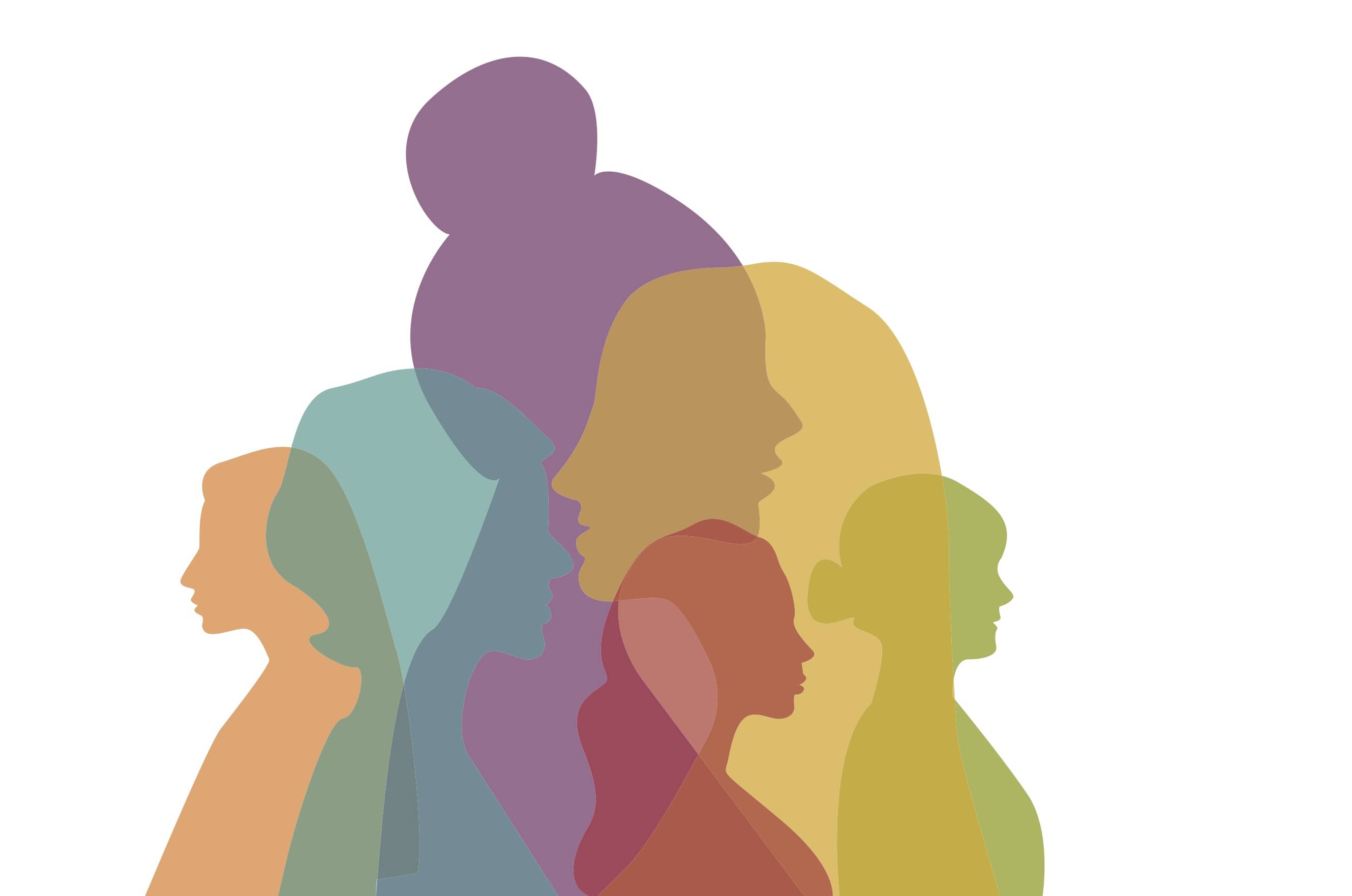
www.buildingsandcities.org/insights/commentaries/gendered-city.html
The Gendered City

Why urban spaces need to be reimagined from an intersectional perspective, incorporating the voices and experiences of women
Cities are hubs of economic activity and cultural vibrancy, however, urban growth policies and city governance that fail to consider gender and poverty have exacerbated socio-economic disparities, exclusion, and segregation. Nourhan Bassan (GamingX) discusses some of key themes from her forthcoming book "The Gendered City". She argues that it is imperative to understand the historical context of urban design, to critically examine gender disparities in cities, and to advocate for women's rights in shaping and accessing urban spaces.
"While women's right to the city was largely left unattended until the recent past, it is important to understand that women have always been active participants in the building of cities. Still, many challenges remain. The progress and success of city policies depend on the capacity to ensure equal conditions and opportunities for people of all genders." - Ana Falú (URBANET 2017)
Gender equality affects everyone
In cities across the world, women of all ages and identities face a range of barriers and vulnerabilities: gender-based discrimination, violence, poverty, expectations of unpaid care work, limited control over assets, and unequal participation in private and public decision-making. For instance, 'Cities Alive: Designing cities that Work for Women' (Arup and UNDP 2022) highlights that only around 1% of women in Africa own their own land, 97% of young women in the UK have experienced sexual harassment in public, 20% of women in India are employed, 95% of women in Glasgow in Scotland, feel unsafe visiting parks at night, 29% of women in business globally are in senior decision-making positions, and 17% of the global population find it unacceptable when a female family member has a job.
The causes of inequality are many, though an underrepresentation of women in local governance institutions and urban design decisions is a major factor, along with there being inadequate accountability mechanisms for urban and municipal policies to address gender inequality. For instance, globally, women make up less than 5% of mayors and only 20% of city councilors. There are pockets of better practice, for instance, there are around double this number of women leaders in the capital cities of Tunis, Freetown, Baghdad, Paris, Bucharest, and Washington DC, though these remain exceptions.
Women perceive and experience cities differently from men and use public spaces in distinct ways. Urban design has been aligned with the work and life patterns of men, meaning our cities often make women unsafe, fail to provide for their basic needs, and restrict their social and economic opportunities. As a result, billions of women are underserved by the urban environments in which they live and work. For instance, women from impoverished and insecure neighborhoods are more likely to commute during late or early hours for educational opportunities work or such as working as vendors in open markets. These routines expose them to the risk of sexual assault. Women often experience feelings of insecurity and vulnerability when navigating public spaces, particularly at night. The lack of well-lit areas, inadequate public transportation, and the absence of safe public toilets further restrict women's freedom to move and fully participate in urban life. Women are also more likely to have inadequate access to basic services, including safe and affordable clean water, sanitation, drainage, electricity, solid waste management, as well as educational, health, reproductive, and social services (IWPR n.d.).
External factors are therefore influencing women's ability to fulfill their basic needs in cities, and the gendered division of labour within the urban economy often places women in low-paid, exploitative, and demanding work while they also maintain their households and communities. This results in a 'triple burden' for women, encompassing reproduction, production and community care. Our urban designs exacerbate this challenge.
In contemporary urban theory, cities are understood as social and historical constructs that are perceived differently by individuals. However, the consequences of historical biases in favour of designs for male needs are still evident today.
Negotiating women's rights to the city
The concept of the right to the city, as proposed by Lefebvre, provides a theoretical framework for advocating urban citizenship rights and participation in decision-making processes (King 2019). It is a radical framework that calls for the transformation of urban spaces and decision making structures. This requires understanding social life and networks, unraveling the ways in which individuals practice citizenship in their everyday lives, and recognizing the agency of marginalized groups in driving urban transformation. This means that designing feminist cities involves reimagining urban spaces from an intersectional perspective, incorporating the voices and experiences of women, and considering factors such as race, class, sexuality, and disability so cities can become more inclusive and responsive to their needs. This will mean that design interventions that improve conditions for women in urban areas will be easier to achieve, such as well-lit streets, accessible public transportation, and gender-responsive infrastructure, all of which can enhance women's safety, mobility, and overall quality of life.
Creating gender-equitable cities
Embracing a gender-responsive approach to urban planning and design ensures that the entire community can access the opportunities provided by cities and generates broader social, economic, and environmental advantages. Addressing the persistent gender disparities in urban settings is urgent, especially considering the rapid pace of global urbanization and the need for reconstruction due to conflicts and climate change. Collaboration among planners, designers, city authorities, community groups, and investors is crucial to effectively tackle these challenges and create resilient and inclusive urban environments that foster social change and yield economic benefits for all.
Gender equality in urban spaces won't happen without challenging gender stereotypes, fostering inclusive dialogue, and actively involving women in shaping urban policies. This requires addressing both the physical environment and the social and cultural norms that perpetuate gender inequities. By creating spaces that embrace diversity, promoting women's leadership, and challenging patriarchal structures, cities can become vibrant and inclusive environments that benefit everyone.
References
Arup and UNDP. (2022). Cities Alive: Designing cities that work for women. https://www.arup.com/perspectives/publications/research/section/cities-alive-designing-cities-that-work-for-women
IWPR: Institute for Women's Policy Research. (n.d.). Gender, Urbanization and Democratic Governance White Paper. National Democratic Institute. www.ndi.org/sites/default/files/Gender%20Urbanization%20and%20Local%20Governance%20White%20Paper.pdf
King, Loren. (2019). Henri Lefebvre and the Right to the City. In S.M. Meagher, S. Noll & J.S. Biehl [eds] Handbook of Philosophy of the City. Routledge. pp.76-86. 10.4324/9781315681597-7
URBANET. (2017). Women's Right to the City: Reflections on Inclusive Urban Planning. https://www.urbanet.info/womens-right-to-the-city/
Latest Peer-Reviewed Journal Content
Designing for pro-environmental behaviour change: the aspiration–reality gap
J Simpson & J Uttley
Lifetimes of demolished buildings in US and European cities
J Berglund-Brown, I Dobie, J Hewitt, C De Wolf & J Ochsendorf
Expanding the framework of urban living labs using grassroots methods
T Ahmed, I Delsante & L Migliavacca
Youth engagement in urban living labs: tools, methods and pedagogies
N Charalambous, C Panayi, C Mady, T Augustinčić & D Berc
Co-creating urban transformation: a stakeholder analysis for Germany’s heat transition
P Heger, C Bieber, M Hendawy & A Shooshtari
Placemaking living lab: creating resilient social and spatial infrastructures
M Dodd, N Madabhushi & R Lees
Church pipe organs: historical tuning records as indoor environmental evidence
B Bingley, A Knight & Y Xing
A framework for 1.5°C-aligned GHG budgets in architecture
G Betti, I Spaar, D Bachmann, A Jerosch-Herold, E Kühner, R Yang, K Avhad & S Sinning
Net zero retrofit of the building stock [editorial]
D Godoy-Shimizu & P Steadman
Co-learning in living labs: nurturing civic agency and resilience
A Belfield
The importance of multi-roles and code-switching in living labs
H Noller & A Tarik
Researchers’ shifting roles in living labs for knowledge co-production
C-C Dobre & G Faldi
Increasing civic resilience in urban living labs: city authorities’ roles
E Alatalo, M Laine & M Kyrönviita
Co-curation as civic practice in community engagement
Z Li, M Sunikka-Blank, R Purohit & F Samuel
Preserving buildings: emission reductions from circular economy strategies in Austria
N Alaux, V Kulmer, J Vogel & A Passer
Urban living labs: relationality between institutions and local circularity
P Palo, M Adelfio, J Lundin & E Brandão
Living labs: epistemic modelling, temporariness and land value
J Clossick, T Khonsari & U Steven
Co-creating interventions to prevent mosquito-borne disease transmission in hospitals
O Sloan Wood, E Lupenza, D M Agnello, J B Knudsen, M Msellem, K L Schiøler & F Saleh
Circularity at the neighbourhood scale: co-creative living lab lessons
J Honsa, A Versele, T Van de Kerckhove & C Piccardo
Positive energy districts and energy communities: how living labs create value
E Malakhatka, O Shafqat, A Sandoff & L Thuvander
Built environment governance and professionalism: the end of laissez-faire (again)
S Foxell
Co-creating justice in housing energy transitions through energy living labs
D Ricci, C Leiwakabessy, S van Wieringen, P de Koning & T Konstantinou
HVAC characterisation of existing Canadian buildings for decarbonisation retrofit identification
J Adebisi & J J McArthur
Simulation and the building performance gap [editorial]
M Donn
Developing criteria for effective building-sector commitments in nationally determined contributions
P Graham, K McFarlane & M Taheri
Join Our Community

The most important part of any journal is our people – readers, authors, reviewers, editorial board members and editors. You are cordially invited to join our community by joining our mailing list. We send out occasional emails about the journal – calls for papers, special issues, events and more.
We will not share your email with third parties. Read more



Latest Commentaries
COP30 Report
Matti Kuittinen (Aalto University) reflects on his experience of attending the 2025 UN Conference of the Parties in Belém, Brazil. The roadmaps and commitments failed to deliver the objectives of the 2025 Paris Agreement. However, 2 countries - Japan and Senegal - announced they are creating roadmaps to decarbonise their buildings. An international group of government ministers put housing on the agenda - specifying the need for reduced carbon and energy use along with affordability, quality and climate resilience.
Building-Related Research: New Context, New Challenges
Raymond J. Cole (University of British Columbia) reflects on the key challenges raised in the 34 commissioned essays for Buildings & Cities 5th anniversary. Not only are key research issues identified, but the consequences of changing contexts for conducting research and tailoring its influence on society are highlighted as key areas of action.